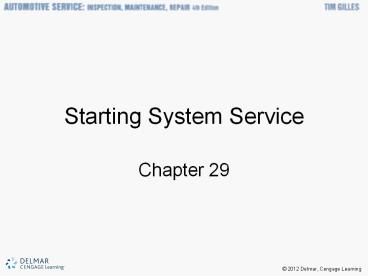Starting System Service - PowerPoint PPT Presentation
Title:
Starting System Service
Description:
Starting System Service Chapter 29 Objectives Measure amperage draw on a starting system Measure voltage drops on both the positive and ground sides of the starting ... – PowerPoint PPT presentation
Number of Views:203
Avg rating:3.0/5.0
Title: Starting System Service
1
Starting System Service
- Chapter 29
2
Objectives
- Measure amperage draw on a starting system
- Measure voltage drops on both the positive and
ground sides of the starting circuit - Diagnose no-crank conditions with a test light
- Replace a solenoid and starter drive
3
Introduction
- This chapter deals with the process for testing
and repairing starter system problems - Principles of operation and electrical
fundamentals in earlier chapters will be
important - Today, many starters are replaced with new or
rebuilt units - Instead of being repaired in the shop
- Local labor rates dictate whether a starter can
be rebuilt economically by the shop
4
Starting System Service
- Failure diagnosis is important before parts
replacement - Most parts stores will not accept returns of
electrical items - Testing a starter follow a logical procedure
- Do not skip steps
- Two types of problems
- Mechanical
- Electrical
5
Starting System Service (contd.)
- Visual check
- Check the wiring connections to see they are
clean and tight - Cable should not get hot during cranking
- Volt-amp tester
- Used to test the starting and charging systems
6
Starting System Tests
- Low battery voltage biggest cause of starter
motor failure - Weak battery solenoid makes a series of rapid
clicks - Starter draws twice the current if battery
voltage drops by half - During starter tests
- Fuel or ignition system must be disabled
- Do not crank the engine with the coil to
distributor wire simply disconnected
7
(No Transcript)
8
Cranking Voltage and Amperage Test
- Using a VAT to check starter motor amp draw
- Clamp inductive pickup around the battery cable
- Cranking test results
- Normally, when the voltage drops, the amperage
draw goes up - When there is resistance, there is a voltage drop
- Cranking speed
- Generally, 250 engine rpm is the speed for a
standard starter
9
Circuit Resistance Test
- Voltage drop testing measures voltage lost when
current flows from source to load - No service required if less than 0.6 volt drop
- More voltage drop requires pinpoint tests
- Normal voltage drop about 0.2 volt
- If voltage drop reading is high, check each
connection in the circuit
10
(No Transcript)
11
No-Crank Tests Using a Test Light
- Engine does not crank
- Usually because of an open circuit
- Use 12-volt test light to see if there is power
at the outlet of the solenoid - If no light, work back through the system until
you find power - Next test is to check the starters ground path
- If the light comes on, the ground path is good
- Starter must be the problem
12
(No Transcript)
13
(No Transcript)
14
Solenoid Problems
- Causes of a rapidly clicking solenoid
- Weak battery
- Corroded or loose battery cable connection
- Open circuit in a hold-in winding
- Single click when battery is in good condition
- Often caused by burned contacts in the solenoid
- Park neutral position (PNP) switch
- Moving shift lever while turning ignition to
start will allow engine to crank - Start switch should be adjusted
15
Solenoid Problems (cont'd.)
- Manual transmissions have a clutch start switch
- Should be no continuity when clutch pedal is up
16
Starter Repair
- Starters may not be economical to rebuild
- Depends on
- Price of parts
- Wages
- Shop work load
- Many shops replace starter drives and solenoids
17
Starter Disassembly
- Considerations
- Mark disassembled parts
- Disconnect solenoids electrical terminals
- Remove two screws that hold solenoid on starter
- Twist solenoid until locking flange is free
- Remove bolts, end frame, and starter body from
drive end housing - Remove armature from the housing
- Inspect bearings or bushings at both ends of
housing
18
Starter Drive Service
- Starter drives often do not last the life of the
starter motor - Before replacing the starter drive with a new
one, count the teeth on the drive pinion - Match old and new to see they are the same
- Inspect the starter ring gear for damage
- Brushes may wear thin and have to be replaced
- Replace whenever a starter taken apart
19
(No Transcript)
20
Starter Reassembly
- Some starters have brushes on pivots
- Others require pulling up on springs that hold
brushes against the commutator
21
Pinion Clearance Tests
- Starter on the bench
- Solenoid energized
- Push pinion back toward armature
- Check clearance with feeler gauge
- Starter on the engine
- Check pinion to flywheel ring gear clearance
- Excessive clearance
- Starter can be loud and teeth can be damaged
- Too little clearance
- Starter could bind and amp draw will be higher
22
(No Transcript)
23
(No Transcript)
24
(No Transcript)































